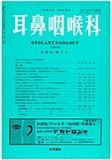Japanese
English
- 有料閲覧
- Abstract 文献概要
- 1ページ目 Look Inside
I.はじめに
音声の使用様式は,個人によりあるいは場所によって種々異なっている。教師,歌手,電話交換手,セールスマン,その他多くの音声を酷使する職業についている人はおろか,一般の人々の発話の実態についても,現在までほとんど見るべき報告がない。日常臨床においても音声障害を訴えて受診する患者の中に音声を酷使した者が多く認められる。また,音声障害の手術的治療後のvoicetherapyが十分とはいえないのも,音声使用の実態を正確に掌握していないためと思われる。
発話の絶対量,発話時間率,音量分布,周波数分布を定量的に掌握すれば,各症例の発話の様子をとらえることができ,発話障害の発症因子との関連や,音声障害が発話に与える影響を知ることができる。また,この結果から,個々の音声障害の発話の状態について,voice therapyの立場から声帯の使用に関して一貫した適切な指導的助言を与えることもできる。この目的のために,ポータブルで24時間の発話時間を積算できる装置を考案し,実際に臨床に応用したので,その成績とともに報告する。
It is well know that voice theraphy is very effective in some cases of vocal cord polyp, polypoid degeneration and singer's nodule. Howevere, we have little knowledge about the total speaking time in a day, the speaking ratio per hour and the sound level during speaking in each patient. If these parameters are detected easily, it must become clear how the speaking time or pattern relates to such a voice disorder or what instruction a doctor should give to a patient. Based on such thoughts, we devised a speech accumulator which counts the vibration time of the vocal cords by a small contact microphone attached on the neck. The speaking time in any sound level is shown as digital data at any time. This handy equipement was clinically applicated to 11 persons and was found very useful. The longest speaking time in a day was 182 minutes in a bus conductress and the shortest time was 33 minutes in an office clerk.

Copyright © 1980, Igaku-Shoin Ltd. All rights reserved.


